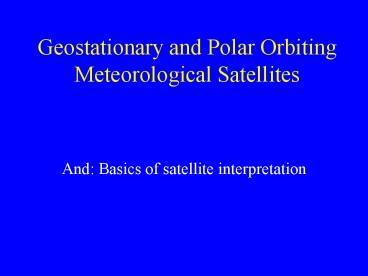Geostationary and Polar Orbiting Meteorological Satellites - PowerPoint PPT Presentation
1 / 43
Title:
Geostationary and Polar Orbiting Meteorological Satellites
Description:
Geostationary and Polar Orbiting Meteorological Satellites. And: Basics of ... Advanced Very High Resolution Radiometer (AVHRR/3) ... – PowerPoint PPT presentation
Number of Views:1967
Avg rating:3.0/5.0
Title: Geostationary and Polar Orbiting Meteorological Satellites
1
Geostationary and Polar Orbiting Meteorological
Satellites
- And Basics of satellite interpretation
2
Radiation in the Atmosphere
3
Geo-Stationary Satellites
4
GOES West East(Actually GOES-E is now GOES-12)
UIUC/NCAR
5
GOES the latest
- GOES-N (13) L6/4/06 O 6/22/06
- Will be in storage at 105W, awaiting K-M failures
- GOES-M (12) L7/23/01 O4/1/03 at 75W
- GOES-L (11) L5/3/00 in storage ready 95W
- GOES-K (10) L 4/25/97 O 7/ 7/98 135W
- GOES-J (9) At 155E operational over Japan
- GOES-I (8) decommissioned drifting
6
GOES I M Mission
- Acquisition, processing dissemination of
imaging and sounding data - Relay of WEFAX data
- Search and Rescue (SARSAT)
7
SARSAT
8
GOES Imager
9
GOES Imager
- Multi-channel instrument that detects IR radiant
from Earth and reflected solar - Channel 1 visible channel 0.52-0.72 microns. At
1 km resolution it is - Useful for cloud identification, pollution, haze
detection, severe storm characteristics
10
4 Infrared Imager Channels
- 3.78 - 4.03 micron (shortwave IR) 4 km resolution
- Fog, and SST determination at night
- Daytime discriminates between water and ice
clouds - 6.47 7.02 microns (upper level water vapor
channel) - 10.2 11.2 microns (longwave IR)
- 11.5 12.5 microns (Split window IR)
- IR sensitive to water vapor
11
Channels 4 and 5 (Longwave IR)
- Thick clouds emit the same amount of radiation at
11 and 12 microns. - Optically thin clouds (Ci) however, do not.
- Subtraction of Ch 5 from 4 yields the Brightness
Temperature Difference - Brightness Temp Differencess display thin clouds
very prominently, as well as ash and dust
12
Shortwave IR Channel 2(3.9 microns)
- Detects (1) outbound Earth IR, but also
- (2) reflected solar shortwave IR during the day
(sun emits mostly IR) - the amount is unknown and varies with the
reflecting material (ocean, snow, sand, cloud,
etc) - Clouds (for example) More reflected IR for water
droplet clouds and much less for ice crystals or
snow covered ground
13
Shortwave IR (continued)
- At night, no reflected shortwave IR and
differences between water ice are due to
emission variations from Earth. - i.e., water/warmer, ice/colder and it emits more
- Water drops emit less radiation at 3.9 microns
than at 11 microns (Channel 4) - Cirrus emit the same amount at both waves
- Subtracting Ch 2 from 4 yields a product that
sharply reveals watery low clouds, stratus and
fog.
14
The water vapor channel
- Detects mid-level moisture content and its
advection - Helps identify mid- and upper-tropospheric
circulation features - Sensitivity to vapor in 300 700 mb range,
peaking at about 490 mb
15
(No Transcript)
16
Satellite Image Analysis Products
17
Winds from Satellite Upper Level
http//www.ssec.wisc.edu/tropic/
18
Winds from Satellite Low Level
19
Wind Shear
20
Upper Level Divergence
21
Low Level Vorticity
22
Sea Surface Winds (QuikScat)
23
(No Transcript)
24
Imager SSTs
25
Black Hills Snowstorm (imager winds)
26
Black Hills Snowstorm (300 mb Div)
27
GOES Sounder
28
GOES Sounder Unit
- One visible band and 18 thermal IR bands
sensitive to temperature, moisture, and ozone - For example, 4 shortwave IR bands near 4 microns
are progressively more sensitive to carbon
dioxide and see deeper into the atmosphere - They enhance the detail of near-earth temperature
conditions (see following slide)
29
(No Transcript)
30
Additional GOES sounder and Imager information
are available at http//cimss.ssec.wisc.edu/goes/g
oesmain.htmlsndrinfoA variety of GOES imager
and sounder products are presented at
orbit-net.nesdis.noaa.gov/goesand some are
illustrated below
31
Sounder Lifted Indices
32
GOES Soundings
33
Polar Orbiting Environmental Satellites (POES)
- Sun synchronous orbits
- Pass close to the poles
- Orbital period about 102 minutes
- 450 nautical miles (800 km) altitude
34
www2010.atmos.uiuc.edu
35
POES Satellites
- Earth rotates below the satellite, which makes 14
orbits a day - Every spot imaged at least 4 times a day
36
Current NOAA POES
- NOAA 12, 14 and 15 all transmit and are
stand-by - NOAA- 16 17 are operational launched 9/21/00
6/24/02 respectively - A.k.a. Advanced TIROS-N satellites (ATN)
- TIROS Television Infrared Observation Satellites
37
ATN Imaging Instruments
- Advanced Very High Resolution Radiometer
(AVHRR/3) - Two Advanced Microwave Sounding Units (AMSU-A and
AMSU-B) - High Resolution Infrared Radiation Sounder
(HIRS/3) - Space Environment Monitor (SEM/2)
38
ATN Instruments Purpose
- AVHRR 6 channels, similar to GOES
- HIRS/3 20 spectral bands calculate vertical
temperature profiles from surface to 40 km - AMSUs a wide variety of applications in
investigating water vapor - SEM solar wind, solar particles
39
Polar Orbiting Satellites
40
Temperature Values
Vertical profilers, using high resolution (by
wavelength) can estimate the values of
temperature at various heights, supplementing the
standard observing network, filling gaps over the
ocean.
41
Sea Surface Temperature
Infrared Satellite data measures the temperature
of whatever is radiating into space. By
accounting for effects of the atmosphere, an
estimate of the surface temperature can be made.
http//www.osdpd.noaa.gov/PSB/EPS/SST/data/FS_km14
gm00.gif
42
Precipitable Water
43
Precipitation Rate

